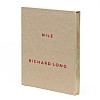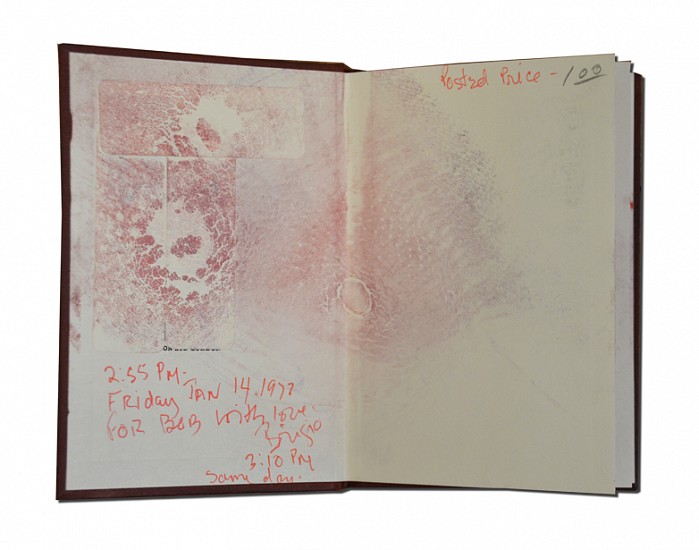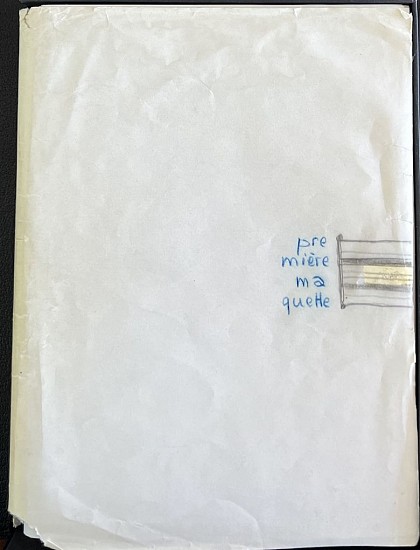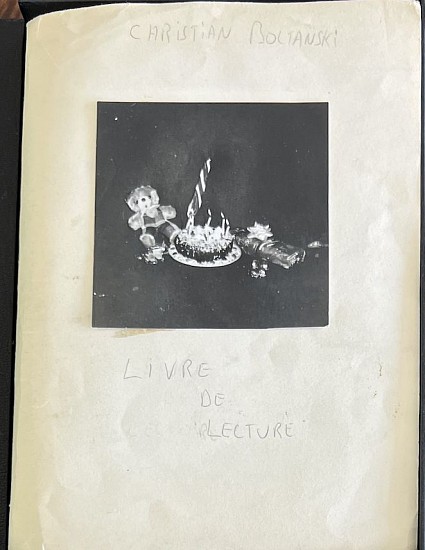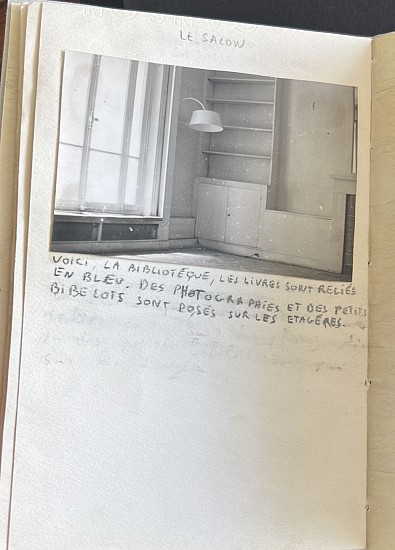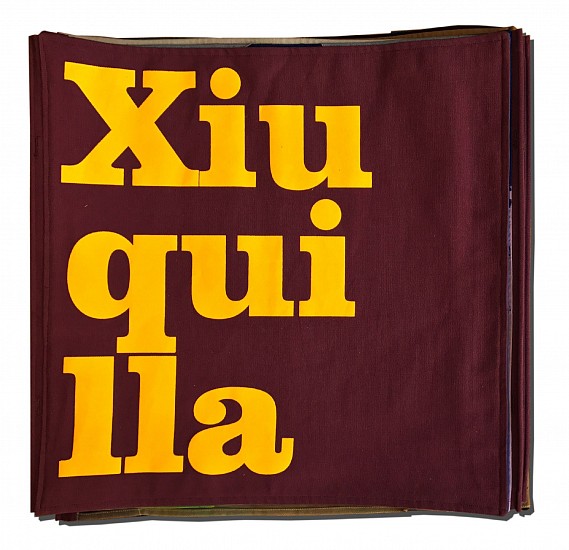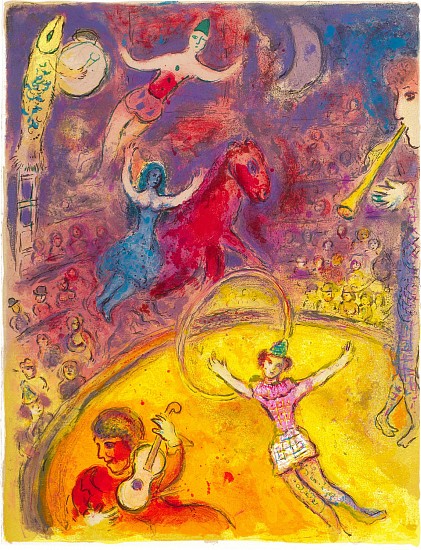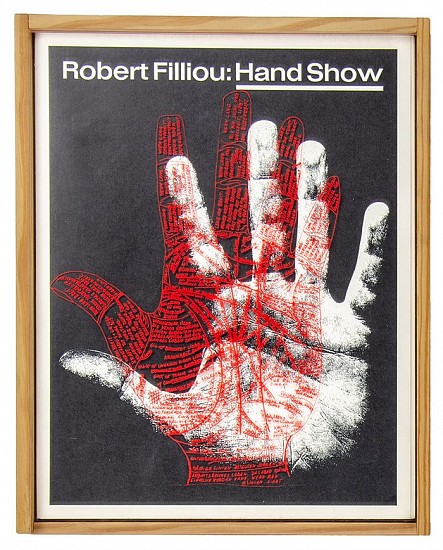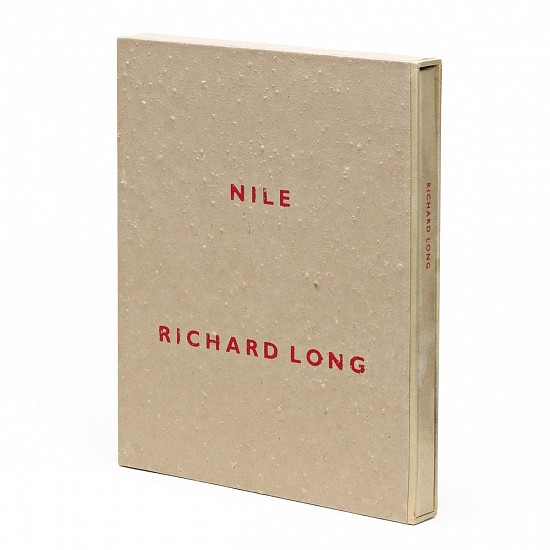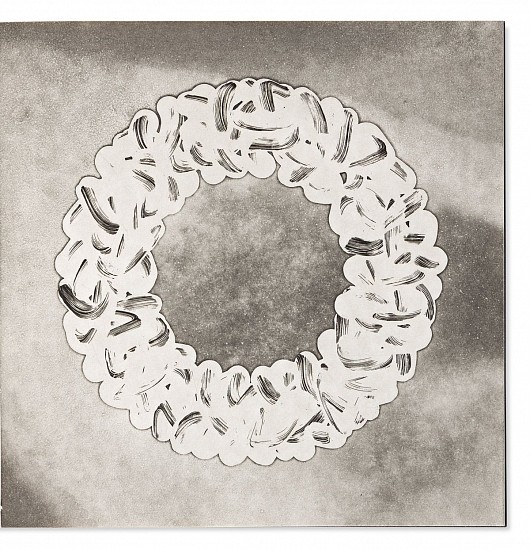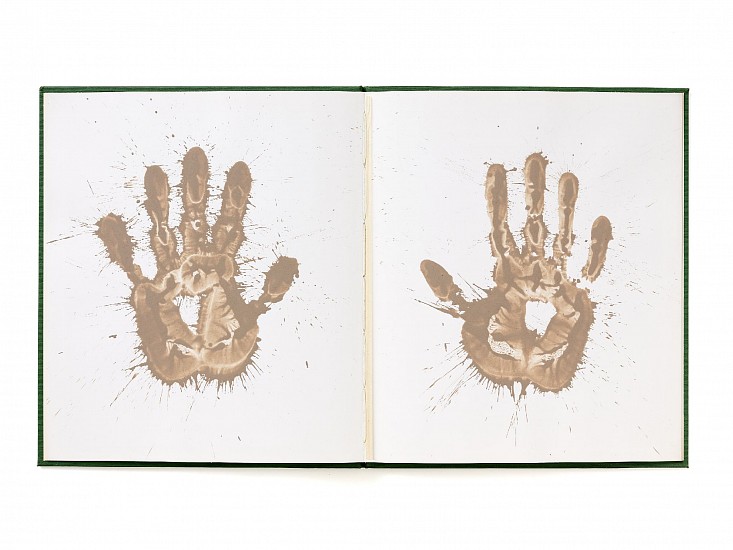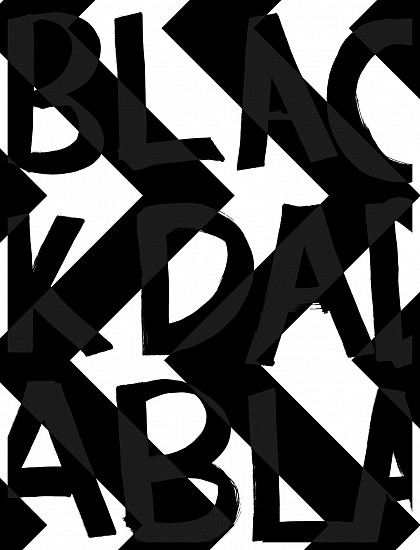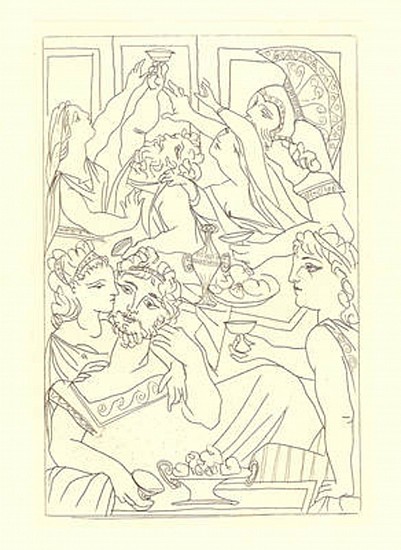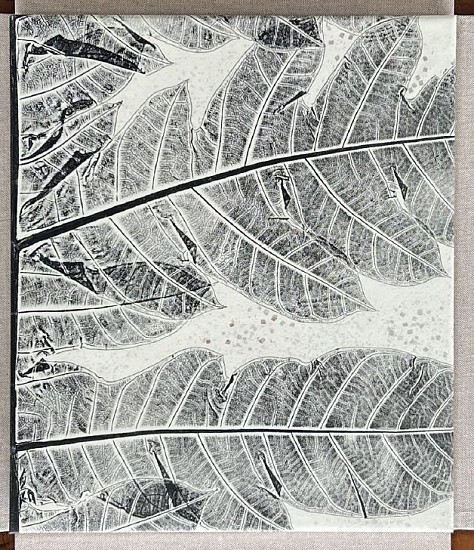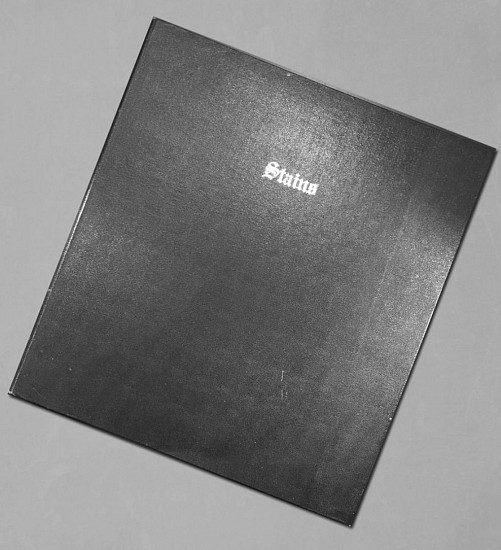IFPDA 2023
Brigid Berlin
Untitled, 1972
4219-BK
6 1/16 x 4 5/16 in. (15.4 x 11 cm)
Former Warhol Factory acolyte, Berlin narcissistically documented her life via Polaroid photographs. This book is a unique example from a series of “tit paintingsâ€â€”colorful prints made by pressing her painted or inked breasts on paper. Inscribed “For Bob with love, Brigid.†Ex-collection Robert Rauschenberg.
Price Upon Request
Christian Boltanski
First original maquette for: Les Modèles. Cinq relations entre texte et image., 1979
13454-BK
8 5/8 x 6 1/4 in. (22 x 16 cm)
Paris. (The artist). Sheets loose in a paper wrapper, with the title “première maquette†handwritten in blue pencil on front, and with
the artist’s pencil rendering of a buckle and strap closing mechanism.
Les Modèles was an artist's book/catalogue published by cheval d’attaque in 1979 on the occasion of Boltanski’s exhibition in the Maison de la Culture de Chalon-sur-Saone. In the published catalogue, five earlier book works by Boltanski were reprinted, with three having being published previously, whilst for the two other books, this was the first time they appeared in print.
The books reproduced in the catalogue were: Recherche et présentation de tout ce qui reste de mon enfance; Tout ce que je sais d'une femme qui est morte et que je n’ai pas connue; L’appartement de la rue de Vaugirard; 10 portraits photographiques de Christian Boltanski, 1946-1964; and Les Histoires.
Here is Boltanski’s first handmade maquette for Les Modèles consisting of 67 loose sheets, 22 x 16 cm format, and includes the handwritten titles and legends as well as all the original photographs that composed some of Boltanski's earliest artist books.
Collation as follows:
11 preliminary sheets, including handwritten half-title, title, and collaged publisher’s imprint;
Recherche et présentation de tout ce qui reste de mon enfance - handwritten title and 8 original silver print photographs (16.8 x 11 cm), cut and glue-mounted on sheets of Vidalon paper, each photograph framed in pen. ‘Recherche et présentation de tout ce qui reste de mon enfance’ was Boltanski’s first artist’s book, originally published in 1969 utilizing photocopies of the same photographs presented here in the maquette. The photographs include a class photo in which Boltanski features in the upper row, second from the left, a piece of his sweater, a shirt etc. In reality, several of these allegedly personal relics belonged mostly to his brothers and nephews;
Tout ce que je sais d'une femme qui est morte et que je n’ai pas connue - three preliminary leaves including handwritten title & 5 offset printed black-and-white photographic images pasted onto Vidalon sheets, handwritten numbering in pencil beneath. Originally self-published by Boltanski in 1970, these five images reproduce photos of an anonymous family (the photos had been given to Boltanski by the Colombian artist Luis Caballero, who had found them in his studio);
L’appartement de la rue de Vaugirard - preliminary leaf with handwritten title, blank leaf & 10 original silver print photographs (each 7 x 10 cm), cut and glue-mounted onto sheets of Vidalon paper, each sheet numbered in pencil. The photographs were taken from a film shot by Boltanski in an empty apartment on Rue de Vaugirard;
10 portraits photographiques de Christian Boltanski, 1946-1964 (originally published 1972) - two preliminary leaves, one with handwritten title, blank leaf & 9 original silver print photographs (each 14 x 9.8 cm), cut and glue-mounted onto sheets of Vidalon paper, each sheet numbered in pencil. With this series of photographs Boltanski in fact got strangers and friends’ children to pose, except for the last photo which is alleged to show the artist at the age of twenty, when he was in fact twenty-eight;
Les Histoires - two preliminary leaves, one with handwritten title, & 9 original silver print photographs (each 6.5 x 9 cm), cut and glue-mounted onto sheets of Vidalon paper. Each photograph framed in pen, and each sheet numbered in pencil. Here Boltanski utilizes a series of photographic images from a children’s story book, here presented devoid of the artist’s deadpan text captions which were to accompany each photograph in the final published version.
[Ref. Bob Calle - Christian Boltanski Artist’s Books 1969-2007, pp. 12, 16, 26/27, 30/31, 33 (original editions of the five books); p. 124 (reference for Les Modèles)].
Sold
Christian Boltanski
Maquette for: Les Modèles. Cinq relations entre texte et image., 1979
13455-BK
7 3/4 x 4 7/8 in. (20 x 12.4 cm)
Paris. Sheets loose in a paper wrapper, with the author’s name and the title “Livre de Lecture†handwritten in pencil on front, together with a pasted down original silver print photograph depicting a still-life from a children’s party.
Les Modèles was an artist's book/catalogue published by cheval d’attaque in 1979 on the occasion of Boltanski’s exhibition in the Maison de la Culture de Chalon-sur-Saone. In the published catalogue, five earlier book works by Boltanski were chronologically reprinted, with three having being published previously, whilst for the two other books, this was the first time they appeared in print.
The books reproduced in the catalogue were: Recherche et présentation de tout ce qui reste de mon enfance; Tout ce que je sais d'une femme qui est morte et que je n’ai pas connue; 10 portraits photographiques de Christian Boltanski, 1946-1964; L’appartement de la rue de Vaugirard; and Les Histoires.
Presented here is a preliminary handmade maquette for Les Modèles, constructed by Boltanski who in fact gave it the title of a “livre de Lecture†or reading book. It consists of 28 lined graph cards, 20 x 12.4 cm format, and includes the handwritten half-titles and page-numbering, as well as collaged printed texts and original photographs that composed some of Boltanski's earliest artist books.
Collation as follows:
1 preliminary sheet of Vidalon paper with titles in pencil and pasted-down original photograph (5 x 9.5 cm) showing a child’s toy beach ball; half-title on lined graph paper, with titles in pen and pasted down silver print photograph; Recherche et présentation de tout ce qui reste de mon enfance - handwritten title and 8 original silver print photographs (each approx. 12.4 x 8.4 cm), cut and glue-mounted onto four sheets of graph card. ‘Recherche et présentation de tout ce qui reste de mon enfance’ was Boltanski’s first artist’s book, originally published in 1969 utilizing photocopies of the same photographs presented here in the maquette. The photographs include a class photo in which Boltanski features in the upper row, second from the left, a piece of his sweater, a shirt etc. In reality, several of these allegedly personal relics belonged mostly to his brothers and nephews;
Tout ce que je sais d'une femme qui est morte et que je n’ai pas connue - handwritten title & 5 offset printed black-and-white photographic images cut and glue-mounted onto five sheets of lined graph card. This maquette also includes Boltanski’s printed texts which accompany each of the images (the sections of printed text are cut and pasted onto versos of each card). Boltanski’s deliberately neutral comments describe each of the pictures as if it was a certified report. Originally self-published by Boltanski in 1970, the five images reproduce photos of an anonymous family (the photos had been given to Boltanski by the Colombian artist Luis Caballero, who had found them in his studio);
10 portraits photographiques de Christian Boltanski, 1946-1964 (originally published 1972) - handwritten title, blank leaf & 7 (of 9, seemingly lacking page 31/32) offset printed black-and-white photographic images cut and glue-mounted onto four sheets of lined graph card. Beneath all but one of the images Boltanski has also crudely cut and pasted his printed captions. With this series of fake autobiographical photographs, Boltanski in fact got strangers and friends’ children to pose for the images;
L’appartement de la rue de Vaugirard - handwritten title and 8 (of 10) original silver print photographs (each approx. 5.9 x 8.3 cm), cut and glue-mounted onto five sheets of lined graph card. The photographs were taken from a film shot by Boltanski in an empty apartment on Rue de Vaugirard;
Les Histoires - handwritten title, & 10 original silver print photographs (each approx. 6 x 8 cm), cut and glue-mounted onto six sheets of lined graph card (includes an extra photograph, with the final published version of the book only utilizing nine photographs). Boltanski here utilizes a series of photographic images from a children’s story book. The maquette also includes the artist’s deadpan text captions which were to accompany each photograph in the final published version, here handwritten in pen beneath each photograph.
[Ref. Bob Calle - Christian Boltanski Artist’s Books 1969-2007, pp. 12, 16, 26/27, 30/31, 33 (original editions of the five books); p. 124 (reference for Les Modèles)].
Sold
Christian Boltanski
Original maquette for: L'Appartement de la rue de Vaugirard. (Handwritten title on front wrapper: Ces genres élémentaires. Florilège. Livre de lecture et de divertissement par Christian Boltanski)., 1973
13453-BK
8 1/4 x 5 7/8 in. (21 x 15 cm)
Stitched into later grey suede-covered wrappers, boxed. With nine original silver print photographs, eight of which measure 8 x 12 cm, with the additional photograph pasted to front cover measuring 8.3 x 8.3 cm.
The unique handmade maquette by Christian Boltanski for his early artist’s book “L'Appartement de la rue de Vaugirardâ€. The maquette consists of 12 pages of thick Vidalon paper, on which are pasted nine hand-cut original silver print photographs by Boltanski. The first image, pasted onto the maquette’s front cover, is of a paper streamer and face mask, whilst the other eight photographs are stills from a film (16mm - black and white) which was shot in the artist's old flat in the rue de Vaugirard in May 1973. Boltanski has titled each photograph in pencil above, and the artist’s handwritten texts below describe a once magnificent life in these now empty rooms. The texts describe furniture and objects which are simply not there, thus evoking a conventional, comfortable life which is now lost. Interestingly Boltanski has clearly agonised over the texts accompanying the photographs, as is evident in the somewhat inadequate eradication of earlier pencil texts with a rubber eraser, and the subsequent rewriting of the lines of text.
The book of which this is the maquette was not actually published until 1991, and then only as part of the boxed set of "Livres" published by the Association française d’action artistique (AFAA).
Sold
Original maquette for: L'Appartement de la rue de Vaugirard. (Handwritten title on front wrapper: Ces genres élémentaires. Florilège. Livre de lecture et de divertissement par Christian Boltanski). | 1973 | Zucker Art Books
Pia Camil
Xiuquilla/Blue milk weed, 2017
09921-BK
19 5/8 x 19 5/8 in. (50 x 50 cm)
Hand sewn cotton leporello book, with screenprinting, in cloth box with colophon.
Published by Zucker Art Books, NY. Edition of 8 variants, with 2 AP.
Each copy is signed and numbered.
Each book is handmade from repurposed fabrics the artist found in Mexico City. Camil’s interventions include cutting shapes common in cloth making such as sleeves, collars, torsos, and recombining them in a colorful array, hand sewn into a double sided sequence. She designed small buttonholes in between the panels so the work can be hung as a banner as well, choosing either side. This sort of interaction between the work and the viewer is a key element throughout Camil’s oeuvre, which even includes works to be worn or walked on.
Pia Camil (b. 1980) lives and works in Mexico City. She has a BFA from the Rhode Island School of Design and an MFA from the Slade School of Fine Art, London. Her work has been exhibited internationally, with recent solo-exhibitions including A Pot for a Latch, New Museum, New York (2016); Skins, Contemporary Arts Center, Cincinnati (2015); The Little Dog Laughed, Blum & Poe, Los Angeles (2014); and Cuadrado Negro, Basque Museum Centre for Contemporary Art, Vitoria-Gasteiz, Spain (2013).
Price Upon Request
Marc Chagall
Le Cirque (The Circus), 1967
17
17 5/8 x 13 1/2 in. (45 x 34.5 cm)
Paris: Tériade. The complete set of 38 lithographs (23 in colors), on Arches paper, the full sheets, loose (as issued), in- and hors-texte, title page, text in French and justification, within original paper wrapper, beige cloth-covered boards with title stamped in gilt on the spine and matching slipcase. This copy comes MINT wrapped in the original papers from the publisher. Edition # 4 of 250.
Price Upon Request
Robert Filliou
Hand Show, 1967
13371-BK
11 3/4 x 9 3/8 x 1 1/2 in. (30.1 x 24.1 x 4 cm)
Wood box with sliding plexiglass lid comprising a folder containing 24 zincographs on cardboard, showing in closeup the left hand of various artists including Andy Warhol, John Cage, Christo, Roy Lichtenstein, Arman, Jasper Johns, Ray Johnson, Alison Knowles, and others. Photographs by Scott Hyde. The plexiglass cover is imprinted with a silkscreened palm covered with annotations in red. Text by artist in German. Published by Edition SABA-Studio, Villingen, Germany. Increasingly scarce as each contribution belongs in the oeuvre of the respective artist. Edition 135 of 150 copies. Signed and numbered in red inside back cover. Very good condition
Price Upon Request
Richard Long
Nile. Papers of River Muds, 1991
13153-BK
12 1/8 x 9 in. (31 x 23 cm)
Folio, publisher's parchment-backed handmade paper-covered boards, red titling to front cover and spine; publisher's single sheet on handmade paper using pulp mixed with mud from the Murrumbidgee River in Australia laid in (numbered 76/172 on blank verso); original parchment-edged paper covered slipcase. Number 76 of 88 copies signed by the artist. The paper used in production was pulp mixed with mud from rivers around the world, producing pages in different shades of brown, from the following rivers: Nile, Umpqua, Hudson, Murrumbidgee, Mississippi, Indragoodby, Jordan, Condamine, Avon, Chitravathri, Amazon, Rhine, Guatiquia and Huang He, first sheet of each example titled in red with the respective river's name. Santa Monica: Lapis Press,
Nile (Papers of River Muds) is a limited-edition book printed by the Lapis Press, Los Angeles. It is usually displayed with its pages open for view next to its slipcase. The slipcase is made with grey hand-made paper with vellum-like edges, and the title NILE | RICHARD LONG is printed centrally in red letterpress. The cover of the book is made with orange-brown, hand-made paper and has a spine made from a vellum-like material. The name of the river UMPQUA in Oregon, USA, is printed centrally in red capital letters. RICHARD LONG is printed in red capital letters on the spine. The hand-bound pages of the book are made of heavy hand-made paper in various shades of brown, their edges left uncut, or ‘deckle-edged’, following the paper-making process. The names of several rivers from around the world are printed on separate pages in red.
Price Upon Request
Richard Long
Dust, Doboros, Desert Flowers, 1987
13151-BK
12 1/4 x 12 1/4 in. (31.1 x 31.1 cm)
Hardcover, paper, includes a 45 RPM record mounted inside back cover, all inserted inside linen covered slipcase (color reproductions). The pigments used for the etchings in this book were gathered by the editor and the artist in Death Valley, CA, in the spring of 1982. The archive has another coy of this record. Edition of 35.
7 etchings using pigments gathered from Death Valley. Square 4to, publisher's black cloth lettered in white; 45 RPM record (“A Round of Desert Flowers†side A) in sleeve mounted to rear pastedown, as issued; original matching slipcase. Signed by the artist. Los Angeles: The Lapis Press
Price Upon Request
Richard Long
Mud Hand Prints, 1984
13152-BK
13 1/2 x 11 1/4 in. (34.3 x 28.6 cm)
London. Coracle Press. [4 unnumbered leaves + guard-leaf]. Small folio. Leaf with title, leaf with left handprint verso, guard-leaf, leaf with right hand print recto, final leaf with colophon verso. Original publisher's green cloth with title to front board in black.
From the edition limited to 100 copies.
"The artist arrived in the premises of the Coracle Press with a bucket of mud from the River Avon carefully mixed to the desired consistency; having made prints of his hands in each of the 100 books, already bound, he threw the remaining mud down the stairwell walls, where the artists who have worked with the Press have all left evidence of their work. Time alone will tell whether the prints created by artist and river will last as long as the preserved image of hands ... made by Paleolithic (Magdalenian) man to be found in caves from the Périgord to the Pyrenees and Northern Spain." [Ref. From Manet to Hockney: Modern Artists’ Illustrated Books (London: Victoria and Albert Museum, 1983, p. 167].
Price Upon Request
Barry McGee
Drypoint on Acid, 2006
1075
7 3/4 x 6 1/4 in. (20 x 16 cm)
Portfolio of 10 prints in a variety of printmaking techniques and collaged silkscreen additions; in a wood box with silkscreen on lid.
Published by Edition Jacob Samuel, Santa Monica, CA.
These images employ collage elements from the artist’s vast collection of old industrial printed paper, which he embellishes with his own images depicting those who live on the margins of society.
Sold
Adam Pendleton
Anthology #6, 2018
11892-BK
18 1/2 x 14 1/4 x 2 in. (47 x 36.2 x 5.1 cm)
Large folio with 200 compositions and a unique cover. Isolated photographs and fragments photocopied from the pages of books are layered with marks, dashes, patterns, shapes, and handwriting that frequently verges on abstraction. Each composition is unique, but many elements iterate and recombine throughout the series: masks, ceramics, phrases (“WHAT A DAY WAS THISâ€; “IF THE FUNCTIONâ€), and historical images related to modernism and decolonization in Africa. The book, which collates the works in chronological sequence, encourages readers to track these recurring components as they phase in and out across the book’s 200 pages.
The compositions are directly related to Pendleton’s collages on mylar and the book translates and indexes these source collages which are usually printed on transparent film whereas in Anthology they have been silkscreened onto Shoji paper. Reflecting on the combinatorial nature of the compositions, each book has a unique cover: a patterned black-and-white canvas fabric, screen printed with one of four handwritten texts.
Copy n 6 of 24
Price Upon Request
Pablo Picasso
Lysistrata, 1934
13579-BK
11 3/8 x 9 1/4 in. (29 x 23.5 cm)
Containing six original etchings, each book signed by the artist. Copy #1319
Price Upon Request
Pablo Picasso
Femme et L'Enfant, 1922
72
8 1/4 x 12 1/8 in. (21 x 31 cm)
Sanguine chalk drawing on handmade paper, signed upper right. Zervos vol. 4 no. 451.
Price Upon Request
Michele Rodda
A Single Leaf, 2021
13576-BK
11 3/4 x 10 1/8 x 3/4 in. (30 x 26 x 2 cm)
Unique artist's book.
This book is a tribute to the diverse vegetation of the tropics.
One nature-printed leaf of Artocarpus elasticus is used for the cover decoration and book, folded in a modified orihon, a Japanese style of concerta folding technique.
The chitsu encloses one nature-printed Victoria cruziana leaf with silver decoration.
Price Upon Request
Dieter Roth
Dieter Roth Graphics, 1952 to 1974
13580-OR
A collection of 26 works (eight of which have multiple images) that exemplifies the breadth of
the artist’s productivity in print shops over a dynamic 22-year period.
A list of some of the techniques Roth employed:
1952 – woodblock print, Spirale 1
1954 – metal relief printing, New Year’s Greeting
1957 – screen print, two color (green and red), UNTITLED
1957 – linoleum block printing, kinderbuch
1958 – photolithograph printing of tape pieces, two color, untitled
1960 – rubber stamp drawing on typed letter to poet André Balthazar
1960 – commercial Iris printing with die-cut holes, Folder designed for Festival d'Art d'Avant-Garde
1961 – screen print with die-cut holes, BEWOGEN BEWEGING
1961 – letter press, book 2b
1961 – photo lithographs from rubber stamp drawings, book 4a
1962 – appropriation of commercial printing- Icelandic POST CARD, untitled
1962 – pencil drawing with letterpress, stupidogram
1963 – photographic unknown reproduction of a symmetric machine drawing, untitled
1963 – embossed drawing with printing plate Wasserhut
1964 – stamp drawing with metal, Feather Fringe, self-dissipating
1969 – multicolor screen prints from a postcard onto color offset, Piccadillies
1970 – solid color screen print on offset, German Cities
1971 – etching and dry point, Duet
1971 – photographic etching with halftone from a polaroid, Icelandic landscape
1972 – etching with food pressings - various 3-dimensional objects added, Containers
1973 – planographic printing, Self Portrait as Inhabitants of the Air
1974 – etching and dry point with photographic etching process for the background, Double
heads
Price Upon Request
Ed Ruscha
Stains, 1969
13165-BK
Hollywood: Heavy Industry Publication, self-published
78 leaves enclosed in a black portfolio, hard cover clamshell box, lined in white silk, with title embossed in silver on the box top and the edge. 75 leaves are animal, vegetable, mineral, and chemical stains hand applied on Eagle Paper Coupon Bond 100% cotton paper; one title sheet is printed black on heavyweight rag paper; one colophon is signed and numbered on white leaf; and one sheet, listing the stains used, is printed black on white leaf. Excellent condition. Signed “Ed Ruschaâ€. Engberg B9.
Copy no. 49 of 70.
Price Upon Request
Ed Ruscha
Set of 16 books from Henry Hopkins, 1963-78
4377-BK
Set comprises 16 seminal books by the artist: Twentysix Gasoline Stations, Various Small Fires, Some Los Angeles Apartments, Every Building on the Sunset Strip, Thirtyfour Parking Lots, Royal Road Test, Business Cards, Nine Swimming Pools, Crackers, Babycakes, Real Estate Opportunities, A Few Palm Trees, Dutch Details, Records, Colored People, and Hard Light. All signed or inscribed to Hopkins except Babycakes, which has the rare â€compliments of author card†signed "give to henry, Ed" from Ruscha enclosed. Hopkins was the curator at the LA County Museum in the 1960s and bought Ed's first painting for the museum. Henry Hopkins directed the San Francisco Museum of Modern Art before returning to UCLA, where he led the Wight Art Gallery and the Hammer Museum in Los Angeles. Dimensions variable.
Price Upon Request
Charline Von Heyl
Sabotage, 2009
13554-BK
11 1/8 x 14 x 1 1/2 in. (28.4 x 35.6 x 4 cm)
Rejecting both written language and illustration, Sabotage is a sort of image-text that gets straight to one of the book format’s most abstract possibilities: the material production of a sort of counterspace that exists beyond meaning. Interspersing transparent (Mylar) and opaque (paper) pages—a selection of the latter have been reconceived for publication here—Sabotage exploits the optical effects of superimposition while riveting the attention of its reader to the basic activity of turning pages. Isn’t this every book’s most intimate desire—to be ransacked and explored by fingers and eyes? Each turned page makes and unmakes the next, and the book remains in a state of constant optical transformation.
Stéphane Mallarmé, too, was fascinated by the fact that a book is above all an optical device—he even addressed the way a volume poses in the glamorous space of a shopwindow. With Sabotage, von Heyl invents something strange and ultimately unknowable with the purely material and energetic qualities of the book: surface and movement, ink and action. She lures the viewer into a readerly relation with her two-sided images. Frequently appropriating fragments of vintage comic books, found photographs, and other ready-made visuals, von Heyl layers and attacks these in such a way that they lose any illustrative function. Sabotage thus pursues a notion of abstraction as a process that resists representation, but that is also cunning and ironic enough to be able to picture itself—rampantly quoting aesthetic histories and styles, striking poses on the page. It is formalism exploiting its own power to leap from one content to another, reprogramming the book as a machine for producing surfaces.
The book has been printed in offset print by Arte-Print, Brussels on MAT. Blacklabel Silk 250gr MAT Magno Mat 400 gr and silkscreen printing by Screen Group, Brussels on transparent PVC 150 microns. Binding by Arte-Print, Brussels, Belgium and Laurel Parker, Montreuil. Slipcase on MAT Blacklabel Silk 150gr assembled by †Les doigts qui rêvent “, Dijon. Format: 46 accordion pages and 23 free Mylar pages. Edition of 100 copies signed and numbered in arabic numerals from 1 to 100 and 17 artists’s proofs. This is copy #10 of 100.
Price Upon Request







